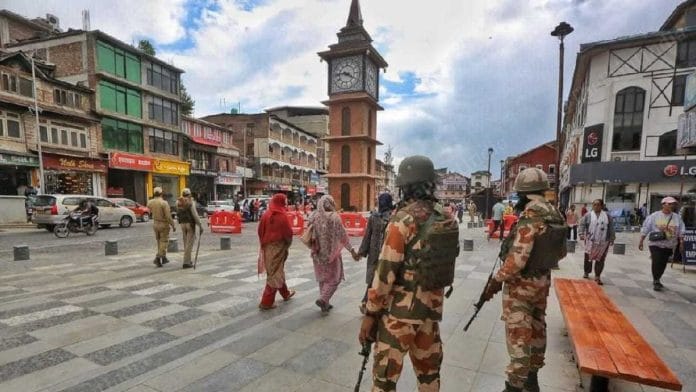Over the decades, New Delhi equated the Kashmir issue with Article 370 (along with Article 35A) of the Constitution of India; Articles that contained special provisions applicable to J&K. And so, with the abrogation of Article 370 through a series of Presidential orders passed by New Delhi in August 2019, the public opinion sought to be built in India has been that the ‘disputed territory’ tag on J&K has been removed.
Witness the opening paragraph of the Approach Paper for the discussion held on 21 December 2019 at the prestigious Army War College at Mhow (India) on The Future Contours of Kashmir:
A Whole of Government Approach that ran as under:
In a momentous decision that should mark the beginning of a new chapter in Kashmir’s history, on 05th Aug 2019, the President of India issued the notification to revoke Article 370 and 35A. In one stroke, the state of J&K has transmuted from being disputed territory to undisputed territory sovereign to India.
However, Article 370 is not of much relevance for the purpose of removing the ‘disputed territory’ tag conferred upon J&K on the international plane. Indeed, the Kashmir issue is not about Article 370, nor is it confined to about 45 per cent of the territory of J&K with India. Abrogation of Article 370 will not convince the world community of India’s stand that the entire territory of J&K is Indian territory and that, consequently, Pakistan and China must vacate the territory of J&K with them.
Nor will it help New Delhi reclaim the residents of such territory as Indian citizens. It seems that it has yet to be appreciated that the genesis of the Kashmir issue is not located in Article 370, nor is its solution. The Indian Supreme Court, in the Article 370 case, upheld the abrogation of Article 370 by New Delhi.
While the Article 370 debate is irrelevant for the purposes of the way forward suggested in this book, some of the findings in the decision of the Supreme Court in the Article 370 case do have the potential to further alter the political discourse on the Kashmir issue. That would entail a discussion, though limited to that extent, of the decision in the Article 370 case. Before examining this decision, let us briefly summarize the constitutional and political developments in J&K post the accession of J&K to the dominion of India.
Constitutional and Political Developments in J&K
As noted in the previous chapter, the ‘popular interim government’ set up by the ruler through the Proclamation of 5 March 1948 was to function under the Jammu and Kashmir Constitution Act of 1939 premised on his supremacy. But then, it was not contemplated that a ruler would remain the constitutional head of J&K within a democratic Indian republic. Accordingly, there was to be a transfer of power from the ruler of J&K to a duly elected constituent assembly for J&K.
And so, the Constitution of India itself contemplated in Article 370 that J&K would have its own constitution framed by its own constituent assembly. Hence, this provision in the Constitution of India of having a J&K constituent assembly to frame the J&K constitution was a mechanism for the transition from monarchy to a form of government within J&K (a constituent unit of the Indian Union), and was not indicative of the future J&K constitution having sovereign character outside or independent of the Constitution of India.
Indeed, the Indian Supreme Court, in State Bank of India, held that ‘the State of Jammu & Kashmir has no vestige of sovereignty outside the Constitution of India and its own Constitution, which is subordinate to the Constitution of India’. However, as on 26 November 1949 – when the Constitution of India was enacted – there was still to be a transition from monarchy in J&K to a form of government that was to be decided by the proposed J&K constituent assembly which was yet to be set up, and which would also further define the existing relationship of J&K with the Indian Union as an integral part of the Indian Union.
Accordingly, Article 370 was described as a temporary provision and placed under Part XXI of the Constitution of India which dealt with ‘Temporary, Transitional and Special Provisions’. Article 370 of the Constitution of India Article 370(1) stipulated that the provisions of Article 1 and Article 370 shall apply in relation to J&K.
The President could apply other provisions of the Constitution of India to J&K relating to the matters specified in the Instrument of Accession as identified above but only in ‘consultation’ with the J&K government, while such application in respect of other matters required the ‘concurrence’ of the J&K government.
Also read: Who has the right to be ‘angry’ in Kashmir? Certainly not its power elite
The Article 370 Debate
It may be noted here that the Constitution of India contains three lists in its Seventh Schedule, distributing the legislative areas between Parliament and the State legislatures. These lists contain legislative entries allotting some matters exclusively to Parliament (Union List), some exclusively to the State legislatures (State List) and some to both Parliament and State legislatures (Concurrent List). Now, Article 370(1) also provided that Parliament could make laws for J&K only with respect to matters in the Union and Concurrent Lists, which were declared by the President of India to correspond to the matters specified in the Instrument of Accession in consultation with the J&K government.
Parliament was empowered to make laws in respect of such other matters in the Union and Concurrent Lists as the President might specify but with the ‘concurrence’ of the J&K government. Article 370(2) required that any concurrence given by the J&K government before the J&K Constituent Assembly was convened for the purpose of framing the J&K Constitution would be placed before such Assembly for such decision as it may take with regard to it.
Article 370(3) enabled the President of India to declare that Article 370 shall cease to be operative or shall be operative only with such exceptions and modifications and from such date as he may specify. That said, the proviso to Article 370(3) mandated a recommendation from the J&K Constituent Assembly to the President before he could do so.
In State Bank Of India, the Indian Supreme Court examined the scheme of Article 370 as under:
Since the Instrument of Accession is an agreement between the erstwhile Ruler of Jammu & Kashmir and the Union of India, it must be respected, in which case if a matter is already provided for in it, it would become applicable straightaway without more, and only consultation with the Government of the State is necessary in order to work out the modalities of the extension of the provisions of the Government of India Act corresponding to the Constitution of India referred to in it.
However, when it comes to applying the provisions of the Constitution of India which are not so reflected in the Instrument of Accession, they cannot be so applied without the concurrence of the Government of the State, meaning thereby that they can only be applied if the State Government accepts that they ought to be so applied.
Under Article 370(2), the concurrence of the Government of the State, given before the Constituent Assembly is convened, can only be given effect to if ratified by the Constituent Assembly. This legislative scheme therefore illustrates that the State of Jammu & Kashmir is to be dealt with separately owing to the special conditions that existed at the time of the Instrument of Accession.
Article 370, therefore, was enacted to give effect to the terms of the Instrument of Accession. It was the Instrument of Accession, and not Article 370, which formed the basis of the constitutional relationship between J&K and the Indian Union. The adoption of Article 370 in the Constitution of India, thus, did not affect the sovereignty of Hari Singh over J&K, which had been retained by him in terms of the Instrument of Accession. Nor did Article 370 of the Constitution of India confer new powers on New Delhi qua J&K.
 This excerpt from Aman Hingorani’s ‘Unravelling the Kashmir Knot: Past, Present and Future’, has been published with permission from Pan Macmillan India.
This excerpt from Aman Hingorani’s ‘Unravelling the Kashmir Knot: Past, Present and Future’, has been published with permission from Pan Macmillan India.






